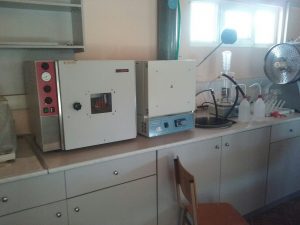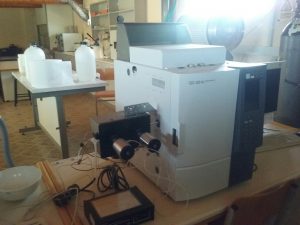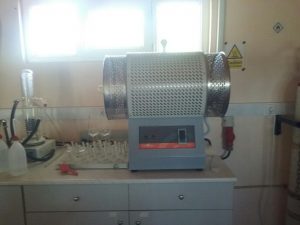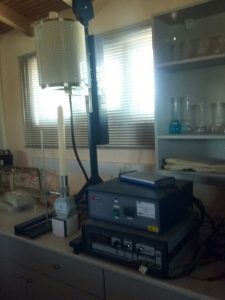Lab Supervisor: Dr. Nikolaos Kiratzis, Professor
Description:
The Laboratory of Advanced Materials & Electrochemical Technology (LAMET) focuses on research themes within the area of fabrication of special functional ceramic as well as ceramic-metal (cermets) composites in the form of thin films suitable for applications such as ceramic fuel and electrolysis cells, ceramic membranes, gas sensors and heterogeneous catalysts. Towards this end, both conventional ceramic processing methods based on liquid dispersions (i.e. tape casting and/or slip casting) as well as innovative molecular deposition methods (such as solution spray pyrolysis) are used. There are also research directions towards natural gas utilization in ceramic fuel or electrolysis cells.

The Lab is equipped with:
- Electrochemical testing and characterization apparatus (Probostat) for testing of elementary (button) cells in various operational modes interfaced with an Ivium electrochemical characterization system. The system set-up allows for simultaneous examination of the performance of various ceramic and/or cermet electrodes by means of an online mass spectrometer (up to a MW of 99) and gas chromatograph.
- High temperature (cylindrical and muffle) furnaces for sintering of ceramic and mixed oxide materials at temperatures up to 1600°C allowing for programmable heating rates. There is also a low temperature drying furnace.
- A planetary ball mill (FRITSCH) for mixing of liquid ceramic dispersions (12-45ml) up to a particle size < 1μm
- Conductivity meter for liquid solutions
- A gas pycnometer for measuring the density of porous pellets (operating with He or N2)
- Electrochemical operation modes allowing for corrosion characterization, battery characterization and/or other types of electroanalytical and/or nano-electrochemistry measurements.
- Solid electrolyte potentiometry (SEP) measurements for electrochemical characterization of metal and/or metal oxides and/or cermets (lamda sensors)
The Lab has supervised several degree theses of undergraduate students funded primarily by the ARCHIMEDES research initiatives (Title: “Development of Solid Electrolyte Fuel Cell Systems for the direct electrochemical oxidation/dehydrogenation of hydrocarbons”) as well as a doctoral dissertation funded by a research grant coded Archimedes III (“Optimization of fabrication processes of solid electrolyte fuel cell components for the direct electrochemical oxidation of hydrocarbons”) in collaboration with Professor Irvine of the Department of Chemistry at the University of St. Andrews, Scotland, UK (Title: Optimization of spray pyrolysis for cathode-supported solid oxide fuel cells)

Collaborators in Greece:
- Μ. Stoukides, Professor, Laboratory of Electrochemical Processes, Department of Chemical Engineering, Aristotle University of Thessaloniki, Thessaloniki, Greece
- Nalbandian, Principal Researcher, Laboratory of Inorganic Materials, Chemical Process & Energy Resources Institute, Centre for Research & Technology Hellas (CERTH), Thermi, Thessaloniki, Greece
- Papastergiades, Associate Professor, Central Research Laboratory, Department of Food Science and Technology, International Hellenic University, Thessaloniki, Greece
- Triantafyllou, Professor, Laboratory of Air Pollution & Environmental Physics (AirLab), Department of Mineral Resources Engineering, University of Western Macedonia, Kozani, Greece
- C.Tsanaktsidis, Professor, Laboratory of Environmetal Technology, Department of Chemical Engineering, University of Western Macedonia, Kozani, Greece

Collaborators abroad:
- Prof. JTS Irvine, Department of Chemistry, University of St. Andrews, UK
- Prof. Ray Gorte, Department of Chemical and Biomolecular Engineering, U. of Pennsylvania, USA
- Prof. P. Luckham Department of Chemical Engineering, Imperial College , UK

Recent publications:
- “Fabrication of Thin Functional Films by Solution Aerosol Thermolysis (SAT)” , A. Krestou, I. Giozis, G. Maroulis, A. Barbatsis, C. Tsanaktsidis, V. Kyriakou, and N. E. Kiratzis, ECS Journal of Solid State Science and Technology, 7 (11) P660-P670 (2018) DOI: 10.1149/2.0251811jss
- “Morphology and Structure of Ceramic Thin Films Deposited by Spray Pyrolysis”, George Tsimekas, E. Papastergiades, and Nikolas E. Kiratzis, ECS Journal of Solid State Science and Technology, (2017) 6 (8) P553-P560 DOI: 10.1149/2.0301708jss
- “Applications of the technique of solution aerosol thermolysis (SAT) in solid oxide fuel cell (SOFC) component fabrication”, N.E.Kiratzis, Ionics (2016) 22:751-770 DOI 10.1007/s11581-016-1704-3
- Fabrication of Thin Electrodic Films by Solution Aerosol Thermolysis (SAT), A. Krestou, I. Giozis, G. Maroulis, V. Kyriakou, C. Tsanaktsidis, and N. E. Kiratzis, ECS Transactions, (2017) 78 (1) 1839-1850 DOI: 10.1149/07801.1839ecst ©The Electrochemical Society
- Morphology and Structure of Solid Oxide Fuel Cell (SOFC) Components Fabricated by Spray Pyrolysis, G. Tsimekas, E. Papastergiades and N. E. Kiratzis, ECS Transactions, 78 (1) 1909-1922 (2017) DOI: 10.1149/07801.1909ecst ©The Electrochemical Society
- Electrochemical Performance of SOFC Components Fabricated by Spray Pyrolysis Method, G.Tsimekas, E. Papastergiades and N.E. Kiratzis, ECS Transactions, 68 (1) 2479-2490 (2015) DOI: 10.1149/06801.2479ecst ©The Electrochemical Society
